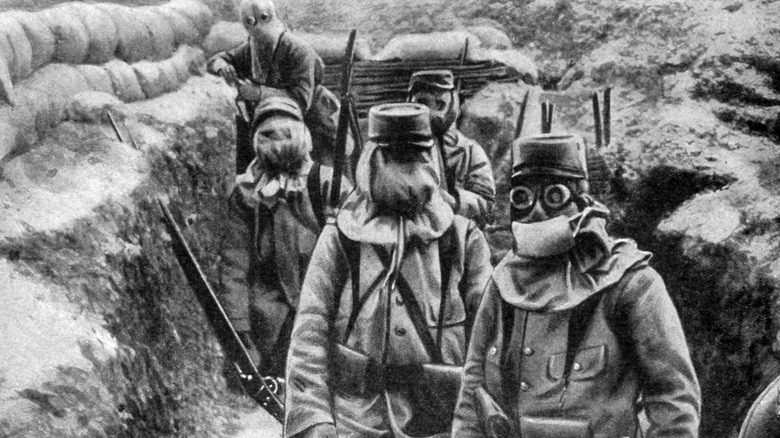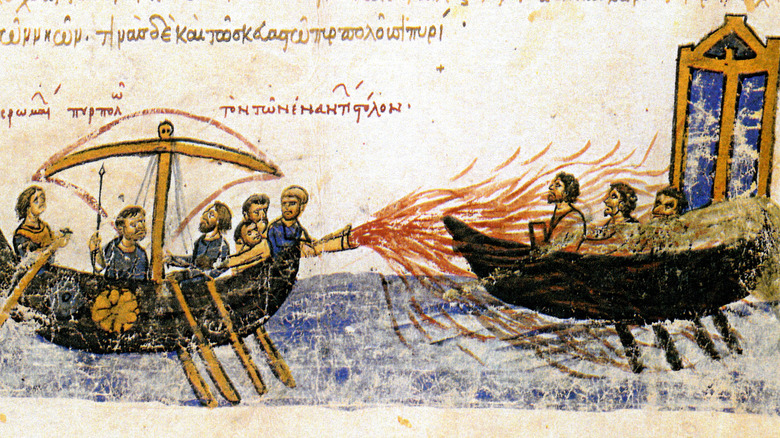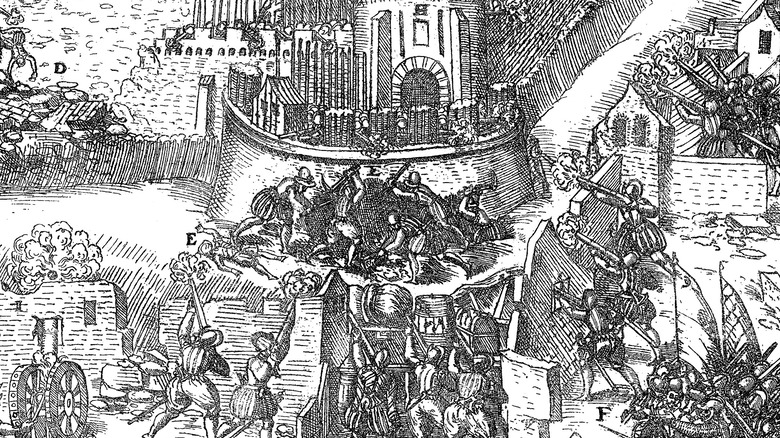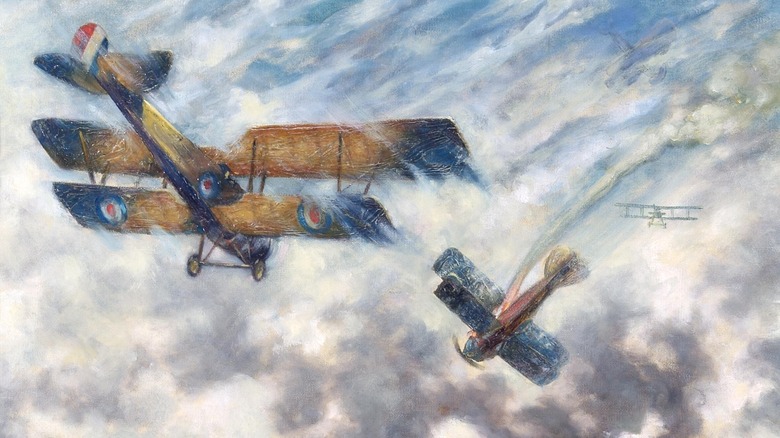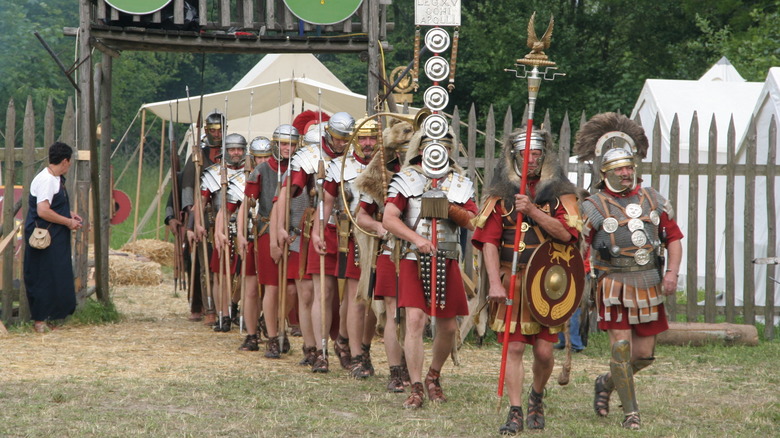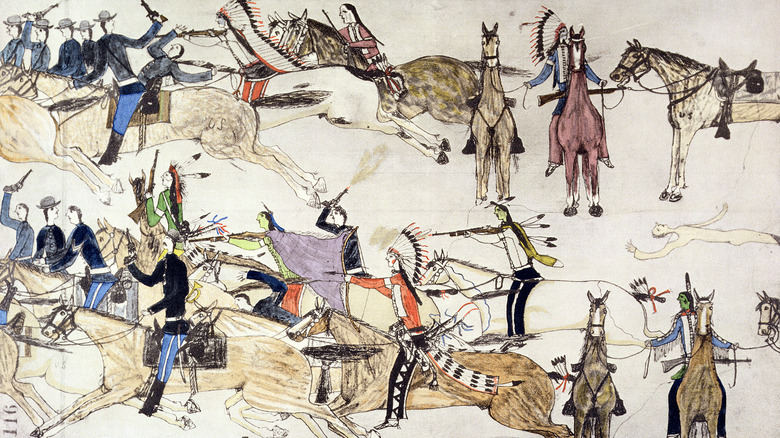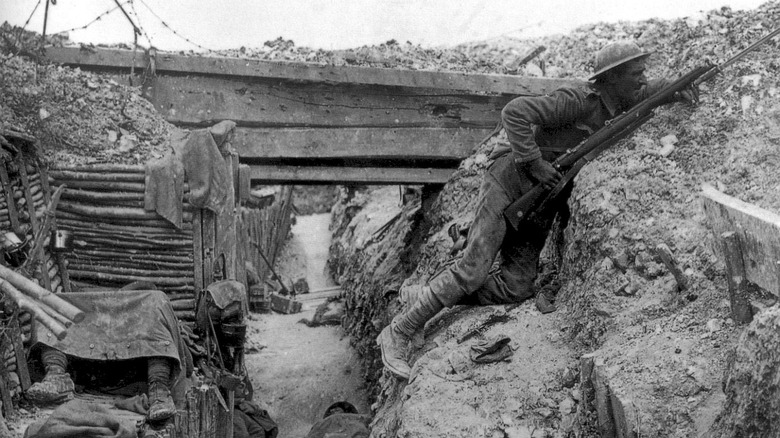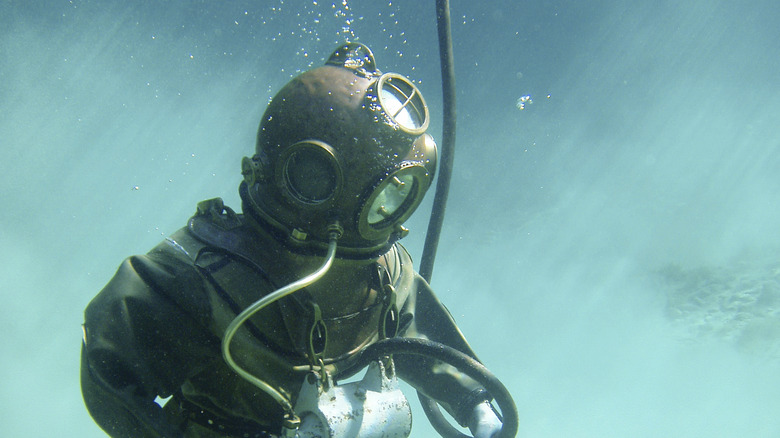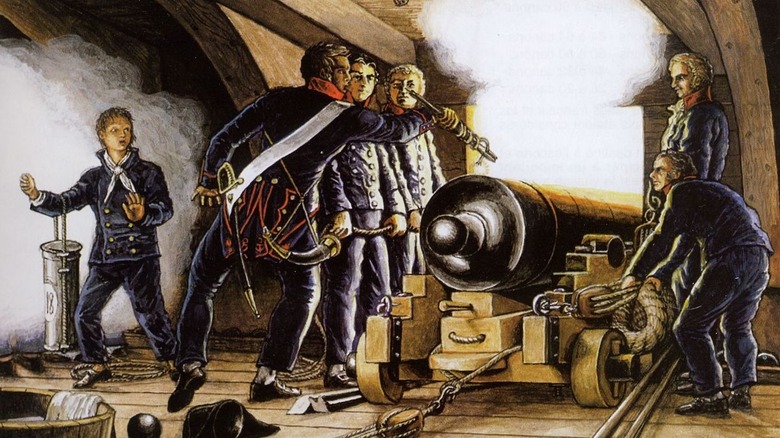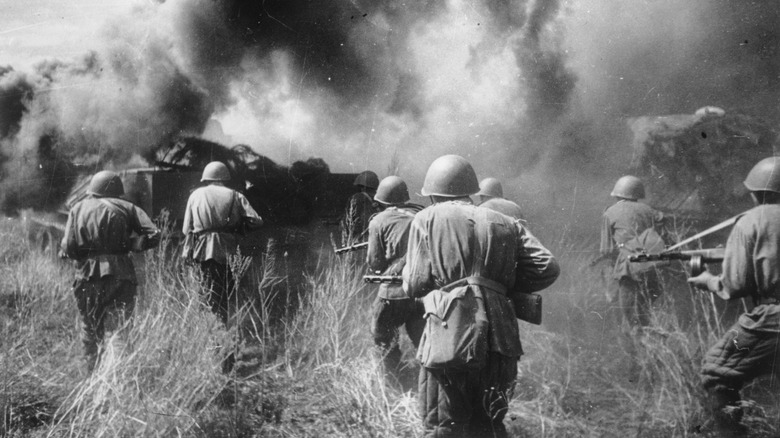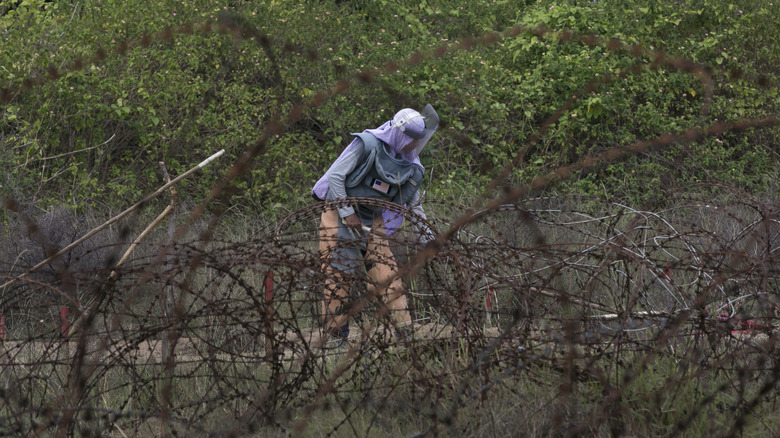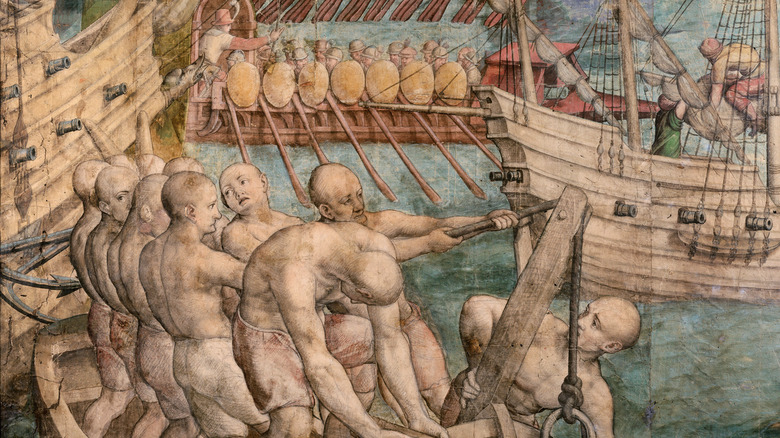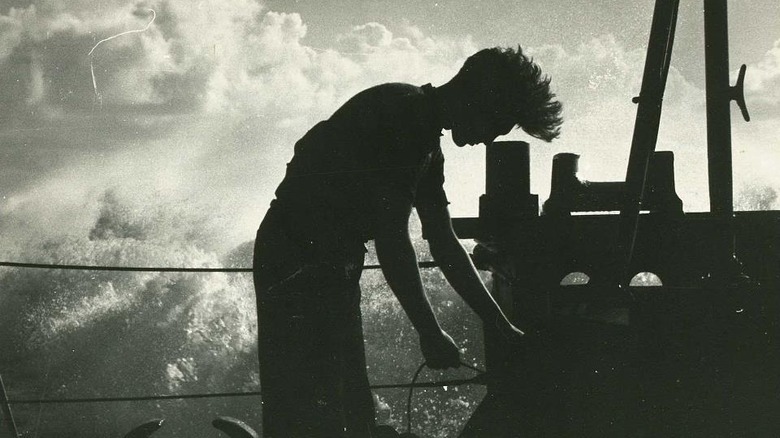Most Dangerous Military Jobs Throughout History
Being in the military is inherently dangerous. The profession's ultimate reason for existing is to fight. However, within the service, some jobs are just so crazy dangerous that they stand above others. Take, for example, submariners during the World Wars. As the article "Stress to the Ultimate Degree" explains, conditions aboard submarines were cramped, and casualties were high from sudden death by depth charge or accident. Among American submariners during World War II, 3,406 died in action out of about 16,000. For Germany it was far worse. "British and German Submarine Statistics of World War II" cites that of 40,900 German submariners, 28,000 died. Clearly submarines go down more than they come up.
Being on a submarine during WWII was hardly the worst occupation in history. This article will examine some of the most dangerous military jobs throughout history. While by no means comprehensive, this list considers those particular jobs that called upon people to put themselves in unusually extreme danger, employ substances or methods which OSHA would not approve of, or, in a couple of instances, force people into appalling conditions with high death rates. Let's now, in no particular order, take a look at some of history's other most dangerous military jobs.
Greek fire operator
The Byzantine Empire had a secret weapon that burned its foes to toast. Greek Fire, as described by Secrecy, Technology, and War, was an incendiary substance that had the virtue of being able to burn on water. Greek Fire was so devastating that it saved the Byzantine capital, Constantinople, multiple times from conquest, most notably with its first use in breaking the siege laid by the Arabs in 678.
Of course, modern flamethrowers are dangerous weapons to use, but those who shot Greek Fire would have been in even greater danger since the technology at the Byzantines' disposal was less sophisticated. Also consider that you couldn't put out this fire with water. Accounts said that once burning, only urine, sand, and vinegar could put the substance out. Operators shot this liquid substance from bronze tubes and syphons in the bows of specially designed fire ships. The operators preheated and pressurized this liquid which then expelled it with a boom that had a range of up to 50 feet. The Byzantines even crafted projectiles with the substance that were catapulted at enemies. While there are no statistics on the number of friendly fatalities from Greek Fire, this weapon was as potentially dangerous to the operators as was their targets.
The composition of Greek Fire is lost to history, according to the World History Encyclopedia, since it was a state secret that vanished with the fall of the Byzantine Empire, and historians have been puzzling over its ingredients ever since.
Ancient and medieval siege sapper
Being involved in a siege in the ancient or medieval world in any capacity was a dangerous proposition. However, being a sapper was arguably the most dangerous job in siege warfare. Sappers, also called miners, as described by "The Siege of Edessa," dug tunnels using single pickaxes under a wall's foundation to destabilize it and make it collapse. This is obviously extremely dangerous because the only thing that prevents tons and tons of castle wall from falling on a miner's head are some hopefully sturdy timbers that they put in place in order to shore it up temporarily. Once the foundation stones had been removed, the miners would then set a fire in their tunnel, which, with good fortune, would burn up the timbers and cause the fortification to collapse.
There was little defense against siege mines except for the defender to dig a countermine in order to intercept the sappers or to wait for a relief force to try to lift the siege. Mining was far more effective against fortifications than siege engines such as catapults or trebuchets. On rare occasions, miners would dig tunnels under a fortification entirely to create a passageway through which the besieging army could pass. Collapses were always a constant threat, and accidents happened frequently. Unfortunately, miners had a low status in the military, and although their jobs were the ones that led to the most successful breaches of fortifications, their deeds are among the least sung.
World War I fighter pilot
Flying aircraft in World War I was seen as a sexy military job using a brand-new technology. Pilots were the "knights of the air." However, there were critical drawbacks to being a World War I flyer, with a high body count being at the top of the list. Fighter pilots during the Great War had incredibly short life spans. According to Maclean's, air crew could expect to survive 10 weeks on average. The Royal Air Force Benevolent Fund notes that 8,000 pilots flying for the Royal Flying Corps (RFC) died in training alone.
This is all explainable by the vulnerable nature of the technology. Flight was new, and pilots were in open seats exposed to the elements and enemy fire. The plane, composed in the classic bi-wing design, was usually constructed of wood and canvas, making it highly vulnerable to fire or collapse. Also, there was no communication available between the plane and the ground. In fact, a pilot and gunner could only communicate through hand signals. It is no wonder that flyers died in appalling numbers. Heck, even friendly ground troops fired on their own planes because they didn't have experience recognizing aircraft, according to the BBC. Pilots were very quickly disabused of their romantic notions of aerial combat.
Roman eagle bearer
Fighting in a Roman legion was a tough business. If you panicked in a fight, or if you mutinied, you might be subject to decimation, which is described by Livius as being the removal of every tenth man, who would be clubbed to death by his fellows. Still, the most dangerous job of all in a Roman legion had to be the eagle bearer. As noted by "Legions in Crisis," each century (group of soldiers) in a Roman legion had a standard bearer, called a signifier. However, the most preeminent standard bearer in a Roman legion was the aquilifer, which, according to "The Roman Imperial Army of the First and Second Centuries A.D.," bore the entire legion's symbol. During the late Republic and Imperial periods, this was the eagle standard called the aquila.
As told by "Military Standards of the Roman Legions," this position held great honor and also typically had control of the legion's pay. However, there were dangers. The aquilifer had to be in the thick of battle. While this earned admiration from the rank-and-file soldiers, it drew the immediate attention of the enemy, who wanted to capture the Roman eagle to demoralize the unit and sow chaos. In other words, if you were an aquilifer, you were a magnet for attack. Aquilifers were charged to protect the eagle at all costs, and as a result, death would have been a common fate.
Plains Warrior Counting Coup
The Native Americans of the Great Plains traditionally put high stock in individual bravery. One job, more truthfully called a rite, of any warrior who wanted to prove his valor and honor was to count coup. Counting coup, according to the Encyclopedia of the Great Plains, basically involved managing to touch an enemy in the heat of battle. In a display of sheer bravado, a warrior would ride or run at an enemy and attempt to touch him with a hand, weapon, or a specialized piece of equipment called a coupstick. This practice not only showed just how brave you were, but it humiliated the enemy as well. As stated by the Encyclopedia of the Great Plains, "Killing was a part of war, but showing courage in the process was more important for individual status."
Consider what counting coup entails. This means riding or running full out at an enemy, dodging arrows or bullets, and just touching them. This was dangerous enough with fighting among tribes, but Plains tribes also counted coup on the heavily armed U.S. military. A warrior who could do this when the bullets were flying was brave indeed.
World War I infantry runners
World War I is duly famous for how it used new technology to find innovative ways to kill lots of people en masse. Machine guns, for example, forced armies, especially on the Western Front in France, to dig into trenches. Stepping out of a trench was an invitation to having machine guns mow you down on the spot. However, in an age where wireless communication was faulty at best, messages had to get through, and so was born one of the most dangerous jobs in military history — runners.
Runners were typically low-ranking NCOs, such as corporals who had one important trait: They were physically fit. These runners tried never to stray into the open, where they were liable to be shot or blown up. Rather, they dashed through the labyrinth network of trenches where, due to zig-zagging, yards became miles. This is not to mention getting caught in mud craters wrought by artillery shells or being suddenly engulfed in poisonous gas. For this purpose, runners were lightly clad but wore gas masks. One World War I veteran commented, as quoted by History, "With a runner, it was merely a question of how long he would last before being wounded or killed."
World War I 'Tin-Openers'
The early 20th century saw great advances in diving technology that allowed humans to begin to access the underwater world. This also led to a great amount of danger. During World War I, German U-boats sunk a great deal of Allied tonnage. The Allies knew it would help their cause greatly if they could recover the latest codes and ciphers in order to try to stop the U-boats. According to History, in 1918, the Royal Navy dispatched deep sea divers to recover codes and ciphers from sunken U-boats.
This was highly dangerous. Most of these boats were sunk in active minefields, which meant that if a diver was in the water when a mine exploded, it could be the end. Also, there were live torpedoes and mines on these sunken U-boats, which could be set off by the explosives divers would use to get into the vessels. Then, of course, there was the harrowing journey through these bus-sized boats, which entailed shifting corpses and rubble while looking for a seemingly innocuous codebook. While incidents certainly occurred, it is miraculous that no diver's next of kin cashed in on the £500 indemnity promised by the Admiralty. These divers were later nicknamed the "Tin-Openers."
Powder monkeys
One job which would break all modern safety and workplace laws was the powder monkey. If you heard of a job which entailed boys as young as 7 carrying explosive material on a rickety ship with explosions all around them, you'd at least inform OSHA. However, in the days before OSHA, and indeed, before regulations on child labor, this was a job for young boys, and it was the worst job imaginable.
According to the National Maritime Historical Society, orphans and boys who ran away from home often signed aboard ships during the Age of Sail. Some of these boys, especially if they were small and fast, might be assigned to be a powder monkey or powder boy. They served a critical function in combat. Since it was inadvisable to have large amounts of explosive gunpowder by the ship's cannons, during a battle, a powder monkey would run down to the ship's hold and carry sacks of gunpowder up to a cannon crew.
Powder monkeys were used by all countries, including the United States during the Civil War. According to the National Museum of the U.S. Navy, these boys, ages 10-14, were the lowest-ranked persons aboard the ship and paid $6 a month. To be a powder monkey was truly a job with low status, low pay, and possible incineration as the only reward.
World War II penal battalions
In 1942, Soviet dictator Joseph Stalin issued Order 227, which established special penal units which punished displays of cowardice during the war. "Penal Units in the Red Army" notes that the practice of assigning convicted or court-martialed soldiers to special units was used in multiple countries dating to the 19th century. Stalin's order specifically called out soldiers who deserted or retreated to be sent to fight in the war's most dangerous sectors. This also followed a similar practice by the Germans under Hitler, which allowed certain individuals to seek pardon from the fascist regime by volunteering to fight in dangerous theaters of action, such as the Eastern Front against the Soviets.
For the Soviets, these units expanded through the war to take in offenders of all kinds. This would later include liberated Russian POWs who were being punished for having surrendered. Being in a penal unit was better, perhaps, than execution, but not by much. Generals viewed these units as completely disposable. For example, in one instance, an indifferent commander sent a penal platoon over a minefield, resulting in 80% casualties.
Deminer
The only thing more dangerous than walking across a minefield is finding and deactivating the mines in that field. According to Smithsonian Magazine, landmines were first heavily used in the Civil War and even today, old minefields plague societies by maiming and killing all who dare to walk across them. Today, the U.N.'s Mine Action Service is committed to decommissioning these old minefields through demining.
In an interview with the BBC, one deminer compared it to archaeology. First, the mine is found using metal detectors, and then it is painstakingly excavated. This is a big job. There are approximately 110,000 unexploded landmines throughout 60 countries, and these mines may date back decades. Deminers really have no idea where they are or when they might inadvertently set them off. Also, the types of mines that they may need to work with vary considerably over the course of history, such as the German "Bouncing Betty," which flew up into the air and sprayed shrapnel in all directions. There has been a concerted effort in recent years to ban mines from warfare, and the 1997 Mine Ban Treaty made some progress, as 162 countries have signed onto the treaty. However, landmines are still being used by nonsignatories.
Demining can provide satisfaction. One deminer, quoted in Journal of Conventional Weapons Destruction, said, "You feel you are actually doing some good when you are actively involved in clearing land in poverty -stricken areas for people to grow crops, collect water and build buildings."
Enslaved war galley rowers
Used off and on from ancient times to the 18th century, captives or criminals were enslaved as galley rowers. As explained by "Galley Slaves," galleys were used by ancient navies for war, such as the famous Greek trireme. However, depending on the period and culture, rowers could have been enslaved or free. The Athenians and Romans, for example, used free rowers. However, other cultures did not, including the Ptolemies of ancient Egypt. This continued so that, as explained by "Mediterranean Slavery, New World Transformations," galley slaves were used by the Spanish, Ottomans, and French, among others.
"The Last Galleys" provides a snapshot on just how terrible this was by discussing the example of French slave galleys from the 16th century. The enslaved were typically branded and sentenced to up to a decade of rowing. They were almost always kept chained and were forced to eat, sleep, and work within their own human waste. If a slave passed out, he was usually cast overboard, though his throat was usually cut first so he didn't have to go through the torture of drowning. And of course, if the ship they were working on went down, their chains would not allow them any means of escape. While the last major naval engagement using enslaved galley rowers was in 1571 at the Battle of Lepanto, the practice continued for at least another 150 years.
World War II Merchant Mariner
One of the most important military functions of the Allies during World War II was getting war materials to countries that needed them. To do this, merchant mariners carried supplies at great hazard overseas to the countries that needed them. Perhaps the most dangerous supply route of all was the so-called "Murmansk Run," which, according to the Imperial War Museum, brought supply ships through dangerous Arctic waters around German-controlled Norway to the Soviet ports of Archangel and Murmansk. Aside from extreme cold and heavy seas, these convoys were subjected to intense attacks by German submarines, ships, and aircraft.
Casualties were extremely high. As explained by Smithsonian Magazine, roughly 9,300 sailors perished in the U.S. Merchant Marine alone. This was a higher casualty rate than any other branch of military service. Some mariners were subjected to torpedo attacks and sinking on multiple occasions, only to just get right back on a ship again after recovery. What made their sacrifices more appalling was that even though they suffered high casualty rates, the Merchant Marine was not considered on par with the other services and denied veteran benefits. They also went largely unpraised after the war compared to the other branches of service. It was only in 1988 that this oversight was rectified.
